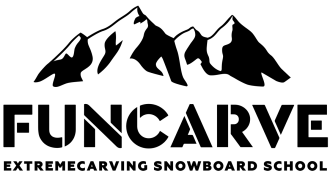Extremecarving. Laid-down turns. Backside
Laid-down turn is the result of usage of several tricks. Only after learning to combine inclination, rotation and vertical motion you can count on success. In fact laid-down turn is extreme inclination in right time and at a sufficient speed. You can get good speed at heavy gradients or by using vertical motion. To enjoy snowboarding regardless of the steepness of the slope you need to learn vertical motion.
Backside laid-down turn is considered to be more difficult in its performance and that’s why it is positioned as the criterion of the highest level of extremecarving technique. However in case of good basic technique it is easier to do backside laid-down turn because on frontside down-unweighting is easier to do due to the anatomy and also in backside laid-down turn it is easier to control the edging angles within the acceptable limits.
Phases of laid-down turns
Phase of rise initiation is added to the usual phases of a carved turn. This phase includes actions of the rider aimed to gentle take off from the slope and to getting the basic position. Unfortunately most of the riders weren’t able to change their perception of carving and they believe mistakenly that it is necessary to rise from the laid-down turn using hands to push them from the slope.
In fact the main role is played by the position of the most massive part of our body – torso. You should learn to use the muscles of your abdominals and back to shift the centre mass slightly higher than the support and then inertia of its motion will lift you up itself.
Backside laid-down turn
In the very beginning of the turn when after edge changing the board still moves along the perpendicular of the slope you should make a deep inclination having your knees bent and to put your forearm on the slope near your leading foot. Then in the process of the turn you should straighten smoothly your legs, body and your forearm which is on the slope until the moment when your board crosses the fall line.
After crossing the fall line you need to initiate the take off from the slope by using the force of your abdominals and simultaneously you need to bend your knees sharply and your hips should be lifted first from the slope! At the moment of initiation and the rise itself you should keep your shoulders in a ‘plus’ position in order to load the nose of the snowboard sufficiently. After the rise you need to finish your turn in ‘plus’ position and to get ready for the edge change.

Typical mistakes
- You support yourself with arms placed on the slope too much. By doing so you decrease the effectiveness of the inclination, you break your 50:50 weight distribution and you lose the speed due to strong friction.
- Entering the turn with angulated body. In such situation your hip touches the slope first and you begin to lose the speed earlier than you put your arm on the snow. You cannot make a good rise from such laid-down turn because by the moment of the rise initiation you will lack the speed tremendously (of course if you aren’t in the Alps).
- You put your forearm to the slope too late. It leads to the late inclination which reaches its maximum only by the breaking phase and also it leads to the fact that you straighten your body not parallel to the slope but up from it!
- Too harsh straightening of the legs leads to board unweightening, it loses the edge and the 50:50 weight distribution gets broken.
- Not enough rotation of the body on backside also leads to broken 50:50 weight distribution and to too early entering the frontside turn.
- Too slow knees bending leads to the loss of lifting force.
- Attempts to push yourself from the slope in order to take off and change the edge. In this case weight of the rider removes from the board and they lose their speed and lifting force.




